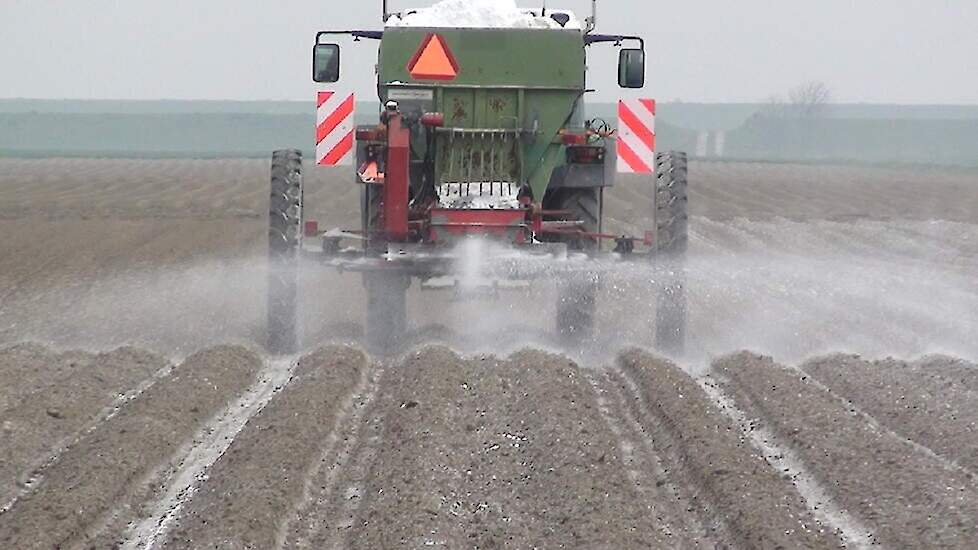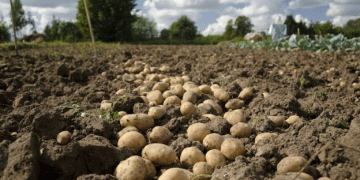Soil pH affects many aspects of crop production, especially nutrient availability.
Most of our main field crops like a neutral soil pH from 6-7. Soils with a pH higher than 7.5 are considered alkaline. This can cause issues with iron and phosphorous availability to the plants due to high calcium carbonate in the soil. Soil testing is the only way to know what the pH level is. Jason Clark is an extension soil fertility specialist at South Dakota State University. He says there is no quick fix, so you have to work with what’s there.
“For field crops, bringing soil pH down with an amendment, there are some out there that tell you to put iron sulfate or elemental sulfur on. But as far as like a broad scale, that’s not as feasible,” says Clark. “So, a lot of things we tell farmers to do is first of all start with your starter fertilizer and make sure you’re getting your micronutrient metals and others there. Sometimes you can add some manure applications to help with some of the nutrient availability.”
He says phosphorous and iron-containing fertilizer can be applied in furrow at planting to facilitate uptake by crop roots before it has a chance to react to alkaline soil conditions. Before you plant anything, hybrid selection is critical when the soil pH is too high.
See More Successful Farming Radio Episode
Soil pH and the availability of plant nutrients
Soil pH is a characteristic that describes the relative acidity or alkalinity of the soil. Technically, pH is defined as the negative (-) log or base 10 value of the concentration of hydrogen ions (H+). Pure water will be close to a neutral pH, that is 10 to the minus 7 concentration of H+ ions (10-7 [H+]). This concentration is expressed as 7. Any value above 7 means the H+ ion concentration is lower than at a neutral pH and the solution is alkaline and there are more hydroxyl (OH-) ions present than H+ ions.

Any value below 7 means the H+ ion concentration is greater than at neutral pH and the solution is acidic. Soils are considered acidic below a pH of 5, and very acidic below a pH of 4. Conversely, soils are considered alkaline above a pH of 7.5 and very alkaline above a pH of 8. Typically, soil pH values are measured when 10 g of air-dried soil is mixed with 20 ml of double-distilled water or 20 ml of 0.01 M CaCl2 solution, and the pH is measured using an appropriate electrode connected to a pH meter. This soil analysis is a regular part of most if not all soil test protocols.
The availability of some plant nutrients is greatly affected by soil pH. The “ideal” soil pH is close to neutral, and neutral soils are considered to fall within a range from a slightly acidic pH of 6.5 to slightly alkaline pH of 7.5. It has been determined that most plant nutrients are optimally available to plants within this 6.5 to 7.5 pH range, plus this range of pH is generally very compatible to plant root growth.
Nitrogen (N), Potassium (K), and Sulfer (S) are major plant nutrients that appear to be less affected directly by soil pH than many others, but still are to some extent. Phosphorus (P), however, is directly affected. At alkaline pH values, greater than pH 7.5 for example, phosphate ions tend to react quickly with calcium (Ca) and magnesium (Mg) to form less soluble compounds.
At acidic pH values, phosphate ions react with aluminum (Al) and iron (Fe) to again form less soluble compounds. Most of the other nutrients (micronutrients especially) tend to be less available when soil pH is above 7.5, and in fact are optimally available at a slightly acidic pH, e.g. 6.5 to 6.8. The exception is molybdenum (Mo), which appears to be less available under acidic pH and more available at moderately alkaline pH values.
In some situations, materials are added to the soil to adjust the pH. However, this is rarely done on a field-scale basis because of the high cost. It is more commonly done in horticulture production applications where individual plant containers or limited areas (e.g. <10 to 20 acres) are managed to lower the pH for acidic soil adapted plants such as some flowers, trees, and/or small fruits (i.e. blueberry and cranberry). It is important to note that most on-going crop production will gradually lower the soil pH as the H+ ions are released and converted over to nitrate by soil microbes. This is especially true where N fertilizers such as anhydrous ammonia, ammonium sulfate, and urea are applied.
Whether or not you try to adjust pH, it is important to understand other methods to increase the availability and use of added nutrients. This can be done in a number of ways for the nutrients mentioned above that are adversely affected by extremes in soil pH, acidic or alkaline. For example, P-containing fertilizer can be applied in or close to the seed-row at planting to facilitate early season uptake of phosphate ions by crop roots before allowing it to react with soil cations that dominate under acidic or alkaline soil pH conditions.

Under alkaline soil pH values, the phosphate fertilizer can be applied in bands with fertilizer which generates an ionized form of ammonia (NH4). That will allow slight acidification of the soil adjacent to the fertilizer band. Another method is to manufacture compound nutrient fertilizer granules that contain the N, P, and even elemental S-containing fertilizers, for application to alkaline soils. The soil adjacent to the granule will also be acidified slightly and allow enhanced P uptake when the crop roots intercept the granules.
Yet another example is the foliar application of soluble Fe fertilizer compounds to Fe-deficient crops grown in high pH soils where the fertilizer react so fast with soil that the nutrient is tied up and unavailable to plants. This is why soil applied Fe fertilizers often do not successfully correct Fe deficiencies. By avoiding the soil and applying the Fe to the leaves, the small amount of plant-required Fe is successfully introduced into the crop.
Next time you have soil samples taken on your fields, take time to note what the pH values are in your results. It is useful to compare these values to previous soil test pH values and determine if there is a trend of soil pH change. By monitoring the pH values regularly (every 2 to 3 years) in a field, you may consider action to raise the pH of the soil from acidic to near neutral pH values by liming.
Increased nutrient availability and improved crop growth can be achieved when adding liming material to an excessively acidic soil. This can be especially important for crops requiring neutral pH, such as legume forages or pulses, as the Rhizobia species bacteria do not nodulate and fix N effectively under pH values less than 5.5






